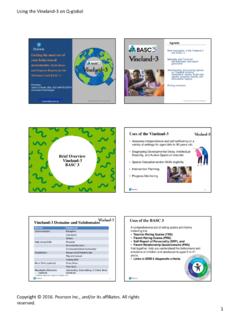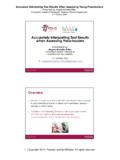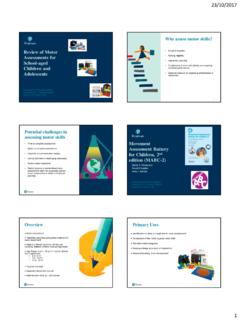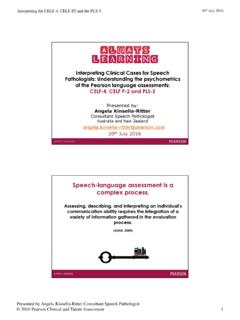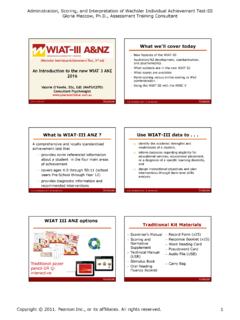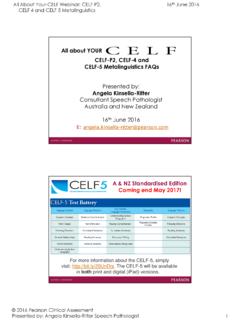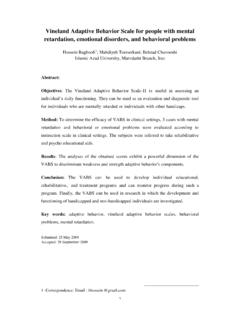Transcription of Vineland-3 Webinar Pearsoon Clinical Assessment VOK
1 Vineland-3 Overview Training ModuleCopyright 2016. Pearson Inc., and/or its affiliates. All rights reserved. 1 vineland adaptive Behaviour Scales, Third Edition3 vineland adaptive behavior Scales, Third EditionOverviewPresented by:Valorie O KeefeConsultant PsychologistPearson Clinical has been updated in the vineland ?How has the structure of the vineland changed?What Vineland-3 Materials are available?What are the new Vineland-3 Form options?Online vs Paper-Pencil administration and scoringQ Global Vineland-3 Standardisation and Psychometrics4 vineland adaptive behavior Scales, Third EditionHistoryVineland Social Maturity scale (1935 & 1965) vineland adaptive Behaviour Scales (1984 & 2008) Vineland-3 (2016)Uses of the Vineland-3 Uses of the Vineland-3 Diagnosing Developmental Delay, Intellectual Disability, and Autism Spectrum disorder Special Education and/or NDIS eligibility Intervention Planning Progress Monitoring Assessing independence and self sufficiency in a variety of settings, ie with older adults7 Defining Intellectual Disability in the DSM-5 Deficits in cognitive functioning ( scores of approximately two standard deviations or more below the mean ) Deficits in adaptive functioning ( , communication, daily living, social participation, and independent living) Onset in the developmental periodSeverity Levels.
2 Defined by adaptive functioning rather than IQ level (different from DSM$IV) Mild Moderate Severe ProfoundVineland-3 Overview Training ModuleCopyright 2016. Pearson Inc., and/or its affiliates. All rights reserved. 2 Differentiating Cognitive Ability from adaptive Functioning Cognitive abilityis generally defined as an individual s repertoire of skills/knowledge that are either innate or acquired. Skills that an individual is capableof performing adaptive Behavioris generally defined as performance of skills that are necessary for personal and social sufficiency. Skills an individual doesperform, independently, in daily activities and routines adaptive behaviour is age$related & is evaluated in a social context. adaptive behaviour is modifiableVineland-3 Updates & Materials12 vineland adaptive behavior Scales, Third EditionVineland-3 UpdatesThree FormsInterview Parent/Caregiver TeacherEach form has Comprehensive and Domain Level Interview Parent/Caregiver TeacherEach form has Comprehensive and Domain Level DomainsCommunication Daily Living Skills Socialisation Motor Skills Maladaptive BehaviourCommunication Daily Living Skills Socialisation Motor Skills Maladaptive BehaviourMaladaptive SectionsInternalizing | Externalizing | CriticalInternalizing | Externalizing | CriticalSubdomains ReceptiveExpressiveWrittenPersonalDomest ic/NumericComm/SchoolInterpers.
3 RelationsPlay & LeisureCoping SkillsGross MotorFine MotorReceptiveExpressiveWrittenPersonalD omestic/NumericComm/SchoolInterpers. RelationsPlay & LeisureCoping SkillsGross MotorFine MotorRemoved the words Rating, Survey, & Expanded. are Skills & Maladaptive Behaviour are available on all forms now, but are Other Motor are optional. Normed on MaterialsParent Interview form:ComprehensiveDomain-LevelParent/Car egiver Questionnaire Form:ComprehensiveDomain-LevelTeacher Questionnaire Form:ComprehensiveDomain-Level1314 vineland adaptive behavior Scales, Third EditionDomain-Level Forms Allow for shortened administration of the Interview, Parent/Caregiver, and Teacher Forms. Provide scores for all domains (Communication, Daily Living Skills, Socialisation, optionally Motor Skills and Maladaptive behavior ) and the overall adaptive Behaviour Composite, but not subdomains. Each can be administered online or via paper booklet.
4 Scores meet AAIDD and DSM$5 requirements for diagnosing Intellectual Disability. Domain forms consist of items drawn from each of the Comprehensive Form subdomains ( , Interview Form Communication domain consists of 45 items sampled equally from Receptive, Expressive, & Written subdomains).15 vineland adaptive behavior Scales, Third EditionDomain-Level Forms Age Ranges Interview Form: 3 to adult Parent/Caregiver Form: 3 to adult Teacher Form: 3 to 21 Administration Time Interview Form: ~25 minutes Parent/Caregiver Form:~10$15 minutes Teacher Form:~10 minutes No basal and ceiling rules!!!! Every item is administeredVineland-3 Overview Training ModuleCopyright 2016. Pearson Inc., and/or its affiliates. All rights reserved. 317 Vineland-3 InstrumentsVineland adaptive behavior Scales, Third EditionInterview FormParent/Caregiver FormTeacher FormComprehensiveDomain-LevelComprehensi veDomain-LevelComprehensiveDomain-LevelC ore adaptive Scores3 Domains9 SubdomainsOverall ABC3 DomainsOverall ABC3 Domains9 SubdomainsOverall ABC3 DomainsOverall ABC3 Domains9 SubdomainsOverall ABC3 DomainsOverall ABCO ptional DomainsMotor SkillsMaladaptiveBehaviorMotor SkillsMaladaptiveBehaviorMotor SkillsMaladaptiveBehaviorMotor SkillsMaladaptiveBehaviorMotor SkillsMaladaptiveBehaviorMotor SkillsMaladaptiveBehaviorAge RangeBirth to 90+3 to 90+Birth to 90+3 to 90+3 to 213 to 21 Item Count502195502180333149 Record Forms1819 Vineland-3 Scoring pages for hand-scoringVineland adaptive behavior Scales, Third EditionQ-global: Online administration and/or scoring platform21 For the Vineland-3 , allows users to administer the Assessment 3 different ways: Manual Entry.
5 Paper/pencil administration with Q-global scoring. On-screen Administration: Administer the Assessment on the screen of any web-enabled device Remote On-screen Administration: Allows a third party ( parent/teacher) to access the Assessment from their own web-enabled device through sending a secure URL via email. Vineland-3 Options 22 OptionsOptionsHand Scoring Administration: Paper Scoring & Reporting: PaperHybrid Administration: Paper Scoring & Reporting: Q-global unlimited subscriptionAll Digital Administration: Q-global Scoring & Reporting: Q-global (pay per usage)For more information about Vineland-3 product options, please (Product tab) Q-global will automatically keep track of basal, ceiling, and subdomain completion rules INTERVIEW FORM: Q-global organises items with related content by topic Interview Topics include 2 to 6 items All information for the items within an Interview Topic is displayed on a single screenMore on Q Global later!
6 Completion Times in Minutes23 Examinee Age Core DomainsMotor Skills(O)Maladaptive behavior (O)Comprehensive Interview Form0-220-254-5N/A3-935-402-33-410-90+25 -30N/A3-4 Domain-Level Interview Form3-90+23-272-3*2-3 Comprehensive Parent/Caregiver Form0-210-153-4N/A3-920-252-32-310-9015- 20N/A2-3 Domain-Level Parent/Caregiver Form3-90+10-152-3*2-3 Comprehensive Teacher Form3-915-201-21-210-2110-15N/A1-2 Domain-Level Teacher Form3-218-101-2*1-2*Ages 3-9 onlyVineland-3 Overview Training ModuleCopyright 2016. Pearson Inc., and/or its affiliates. All rights reserved. 4 Structure of the vineland -325 Updated Item Content of the Vineland-3 Items were updated to reflect changes in daily living ( , technology) and in conceptions of developmental disabilities ( , autism) Outdated items were dropped or modified Items are more general in wording to allow for potential cultural differences Understands what direction his/her language is written in Responds politely when given something ( , more general than says thank you ) Maintains culturally appropriate eye contact during social situations Efforts to reduce redundancy and streamline similar items to specific subdomains ( , moving all conversational items to Socialization)
7 vineland adaptive behavior Scales, Third EditionVineland-3 Domains and Subdomains26 DomainSubdomainCommunicationReceptiveExp ressiveWrittenDaily Living SkillsPersonalDomestic/Numeric*Community /School Community*SocialisationInterpersonal RelationshipsPlay and LeisureCoping SkillsMotor Skills (optional)Gross MotorFine MotorMaladaptive Behaviors(optional)Internalising, Externalising, & Critical Items (Sections)* A different subdomain is used in the Teacher FormDefinitions of Vineland-3 adaptive behavior Subdomains28 Domain and SubdomainDefinitionCommunicationReceptiv eAttending, Understanding, and responding appropriately to information from othersExpressive Using words and sentences to express oneself verbally to othersWrittenUsing reading and writing skillsDefinitions of Vineland-3 adaptive behavior Subdomains29 Domain and SubdomainDefinitionDaily Living Skills DomainPersonalSelf-sufficiency in such areas as eating, dressing, washing, hygiene, and health careDomestic (a)Performing household tasks such as cleaning up after oneself, chores, and food preparationNumeric (b)Using numeric concepts in practical ways, including time, dates, and moneyCommunity (a)Functioning in the world outside the home, including safety, using money, travel, rights and responsibilities, Community(b)
8 Meeting expectations for appropriate behavior within the school environmenta Interview & Parent/Caregiver Forms onlyb Teacher Form only Definitions of Vineland-3 adaptive behavior Subdomains30 Domain and SubdomainDefinitionSocialisation DomainInterpersonal RelationshipsResponding and relating to others,including friendships, caring, social appropriateness, and conversationPlay and LeisureEngaging in play and fun activities with othersCoping SkillsDemonstrating behavior and emotional control in different situations involving othersVineland-3 Overview Training ModuleCopyright 2016. Pearson Inc., and/or its affiliates. All rights reserved. 532 Vineland-3 Motor Skills DomainOptional, and no longer contributes to ABCSUBDOMAIN Gross Motor Fine MotorVineland adaptive behavior Scales, Third EditionITEM DESCRIPTION How an individual usesarms & legs for movement & coordination How an individual uses hands & fingers to manipulate objectsThe Motor Skills domain is normed from birth 9 years.
9 Though optional, it can be very useful to administer to individuals of any age with suspected or known motor Maladaptive behavior DomainOptional, and now included on ALL forms! Measures undesirable/atypical behaviors that interfere with adaptive functioning Rather than measuring the absence of an adaptive behavior Ages 3+ All items are administered 3 areas of maladaptive behavior : Internalising ( , anxiety; depression) Externalising ( , hyperactivity; disruptive behavior ) Critical Items ( , self$injury; suicidality; aggression)A closer look at the new Vineland-3 FormsInterview FormsVineland-3 Interview Forms: The interviewer does not read the items to the respondent or ask him/her to provide item scores. The interviewer uses open-ended questioning to prompt the respondent to talk about the examinee s behaviour in the adaptive areas that are assessed. The interviewer then uses the information to score the items himself/herself.
10 This is different from the Parent/Caregiver form, where the items are read and scored by the parent/caregiver on his/her own (both forms do cover the same adaptive areas).36 Interview Forms37 Vineland-3 Overview Training ModuleCopyright 2016. Pearson Inc., and/or its affiliates. All rights reserved. 638 Comprehensive Form3940414243 Vineland-3 Overview Training ModuleCopyright 2016. Pearson Inc., and/or its affiliates. All rights reserved. 744 vineland adaptive behavior Scales, Third EditionBasal & Ceiling RulesComprehensive FormsFormBasal/CeilingVINELAND-3 ComprehensiveInterviewBasal4 consecutive scores of 2 Ceiling4 consecutive scores of 046 Introduction of Estimated Items47 Options of Don t Know and No Opportunity item response options from vineland -II have been removed New Estimated Item response options available for every item across all 3 forms48 vineland adaptive behavior Scales, Third EditionEstimated Items Estimated Box: If the respondent has not observed the behavior , ask him/her to estimate a score then check the Estimated Box The % of estimated items per section is the # of estimated items divided by the total number of items answered If 2+ sections of the form have >25% estimated items, the form may be invalid% Est < 15%:Validity is not compromised% Est 15% but < 25%:Interpret with caution% Est 25%.
